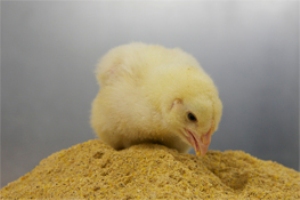Nov 4 2013
Chickens could be the unexpected beneficiaries of the growing biofuels industry, feeding on proteins retrieved from the fermenters used to brew bioethanol, thanks to research supported by the Engineering and Physical Sciences Research Council (EPSRC).
 Chick eating chicken feed
Chick eating chicken feed
It has long been known that the yeasty broth left over after bioethanol production is nutritious, but it has taken a collaboration between Nottingham Trent University and AB Agri, the agricultural division of Associated British Foods, to prove that Yeast Protein Concentrate (YPC) can be separated from the fibrous cereal matter.
The researchers have also shown that YPC may be a cost-competitive substitute for imported soya-based and similar high-value protein feeds currently used in the diets of chickens bred for meat production.
The project was born out of the vision of biofuels pioneer Dr Pete Williams of AB Agri, who was convinced valuable material was being overlooked when cereals were fermented to make bioethanol.
With Dr Emily Burton of Nottingham Trent University, he was able to secure funding from the EPSRC for a CASE* studentship that allowed them to develop and analyse the process.
To establish the nutritional value of the concentrate, EPSRC CASE student Dawn Scholey examined the composition of the newly isolated, patented YPC in a series of experiments, which showed that it can be readily digested by chickens. A paper outlining this research is published in this month’s issue of the journal ‘Food and Energy Security’**.
Project supervisor, Dr Burton says the work is only just beginning: “Bioethanol is already a 60-billion-litre per year global market but this project shows the fuel itself is only half the story – immense value lies within other co-product streams too. As well as the proteins, the yeast content provides important vitamins and other micronutrients.”
Produced by distilling and fermenting wheat and other agricultural feedstocks, bioethanol has particular potential for use as a petrol substitute. Currently, the dried distiller’s grains with solubles (DDGS) generated as a co-product are sold to the cattle-feed market but this is not big enough to absorb all material that would be generated if bioethanol production ramps up significantly in future.
Dr Burton believes the project helps address an issue often raised in connection with cereal-based biofuels: “One concern with bioethanol is the perception it will compete with food crops for limited farmland. Our new work shows how the two can live side by side.”
The new, patented process separates DDGS into three fractions – fibre, a watery syrup and YPC, allowing global production of almost 3 million tonnes of supplementary high-quality protein per annum alongside current levels of bioethanol produced. A project at a US bioethanol facility is now up and running, demonstrating the performance of the process at factory scale.
Every year, 800 million chickens are reared for meat production in the UK and 48 billion worldwide. As well as helping to feed these birds, YPC could partially replace the fish meal used on commercial fish farms.
Dr Pete Williams of AB Agri, the industrial sponsor of the work, says: “We couldn’t have got this development started without the EPSRC CASE studentship that allowed us to establish the proof of concept, and to confirm the value-creation potential of our innovative separation process. By helping us to move to the next key stage of development, it has brought closer the prospect of full-scale industrial use that could deliver major benefits to the emerging ‘green’ fuel sector.”
*CASE (Cooperation Awards in Science and Engineering) funding is provided by EPSRC for PhD students working with businesses on research projects of industrial relevance.
**The ‘Food & Energy Security' paper can be viewed at http://onlinelibrary.wiley.com/doi/10.1002/fes3.30/abstract